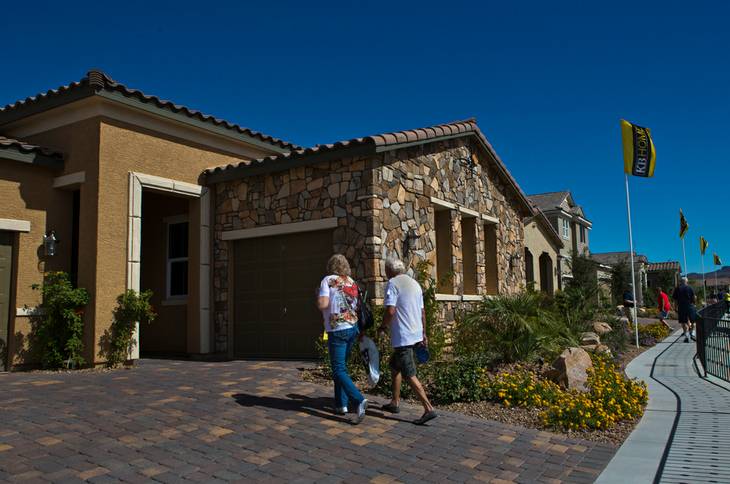LOS ANGELES — The market for new U.S. homes strengthened for much of 2015, with sales rising 14.5 percent through the first 11 months of the year. Steady job growth and low mortgage rates spurred sales higher. At the same time, rising prices amid a dearth of available resale homes in many markets remain hurdles for many would-be homebuyers.
Despite advancing further last year, sales of new homes remain below their 52-year historic annual average of 655,200. They hit a seasonally adjusted annual rate of 490,000 in November.
Earlier this month, KB Home reported lower-than-expected revenue for its fourth fiscal quarter as harsh weather in some parts of the country and labor shortages delayed the completion of some homes.
Jeffrey Mezger, president and CEO of Los Angeles-based homebuilder KB Home, weighs in on how his company is faring ahead of this year's spring home-selling season and gives his take on the state of the housing market overall:
Q: Where would you say we are in the U.S. housing recovery now and how long before the market gets to normal?
A: On the new-home side we're at about 60 percent of the 40-year average. So we're crawling up incrementally. It's still a few years before you get back to "normal."
People ask me where are we at in the cycle. I don't know that we're in a cycle right now because we're so far below the norm. Things are getting better. I don't think we're at risk of a bubble and I don't think we're late into a cycle, I think we're just slowly recovering right now.
Still recovering from the housing bust nearly 10 years ago?
Yes.
Who is the main customer you're selling to now? And which segment — first-time buyer, move-up — do you see real growth in this year?
Our average selling price is up over $100,000 in the last three years. And it's up because of the locations we're building in and the types of homes, not because the market has let us raise prices that much.
We're finding in those locations a well-heeled first-time buyer. Or because we're in the Sunbelt, we attract about 15 percent move-downs, where they don't want to live in an age-restricted community and they want to stay in Phoenix or Tucson or Austin or something.
Right now we're 50 percent first-time, 15 percent move-down and about 35-percent first- and second move-up.
It wouldn't surprise me if we actually tilt to more first-time (buyers) because the millennials are starting to come out and buy homes.
Many homebuilders continue to face rising labor costs as subcontractors have difficulty finding skilled workers. How much of a problem is this for you?
The subcontractor situation is getting a little better. While labor has been tight for two or three years, our average build time in the first three quarters of this year was within a day each quarter, 108-109 days. In the fourth quarter our average build time was 122 days.
So, we've been dealing with labor shortages for a few years and we've been very predictable.
We'll get through it, but you look at how many people left our industry and how we're getting our volume back, just this little spike we saw in '14-'15 really pinched the subcontractor base. It's a much nicer problem to have than 'Can we sell a house today?'
With the inventory of homes for sale tight in many markets, why aren't homebuilders building more? Is the labor shortage a factor?
A little bit. A bigger challenge is finding enough land that you can invest in and get returns on in a big enough way to really drive volume in our industry. There's no question there's pressure on costs, but the pressure to have entitled and finished lots on the ground is bigger right now.
In many of the markets where there's a lot of land available to get entitled it's in areas where the economics don't work yet. So you're not going to spend a lot of money entitling land where you can't get a return after you develop the lot and build the home.
In the land-constrained areas where it's more desirable and more active, there's less land around. So you have a supply constraint in the more desirable areas and you have a demand issue where the land is available in some cities.
You'll meet in the middle over time, but we're not there yet.
How do you see this year shaping up for KB Home compared to 2015, given the state of the housing market?
We're bullish in that the housing markets have a long way to go to get back to historical levels. As much as they've improved, there's still a lot of room to run. Between our backlog position and our communities that are open and the way we're performing, we're projecting continued improvement in revenue, margins, profit — all the metrics.
I can also share that in our fourth quarter our traffic per community, which is a great indicator of future sales, was the highest it's been since 2007.
What about mortgage rates?
I don't think you'll see much mortgage rate movement until or when the Fed lifts its rate more. This first quarter point move won't move mortgage rates. Does the next quarter point? I don't know. Mortgage rates are so favorable right now around the 4-percent mark, affordability is very compelling right now.

